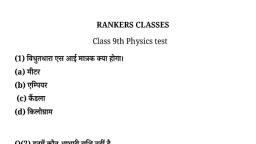Question 1 :
Find out whether or not the first polynomial is a factor of the second polynomial<br/>$x-3, x^3+4x^2-3x+5$
Question 3 :
Square root of $\dfrac {x^{2}}{y^{2}} + \dfrac {y^{2}}{4x^{2}} - \dfrac {x}{y} + \dfrac {y}{2x} - \dfrac {3}{4}$ is $\dfrac {x}{y} - \dfrac {1}{2} - \dfrac {y}{2x}$
Question 4 :
Simplify: $\displaystyle \frac { 49\left( { x }^{ 4 }-2{ x }^{ 3 }-15{ x }^{ 2 } \right)  }{ 14x\left( x-5 \right)  } $
Question 6 :
Two distinct ________ lines cannot be parallel to the same line.<br/>
Question 8 :
<br/>Two supplementary angles are in the ratio $3:2$. The smaller angle measures?
Question 9 :
After covering a distance of $30\ km$ with a uniform speed there is some defect in a train engine and therefore its speed is reduced to $\dfrac{4}{5}$ of its original speed. Consequently the train reaches its destination late by $45$ minutes. Had it happened after covering $18$ kilometers more the train would have reached $9$ minutes earlier, find the speed of the train and the distance of journey.
Question 10 :
Find the value of $k$ for which the following system of linear equation becomes infinitely many solution or represent the coincident lines.<br>$6x+3y=k-3$; $2kx+6y=k$
Question 11 :
The budget for the annual day function of a school was Rs. $60,000$, out of which Rs. $14,500$ was paid to the tent house, Rs. $10,400$ to the band party and Rs. $5,000$ for refreshments. How much money was left over after meeting the expenses?
Question 12 :
The cost of using a telephone in a hotel meeting room is $ $0.20$ per minute. Which of the following equations represents the total cost $c$, in dollars, for $h$ <u>hours</u> of phone use?
Question 13 :
If a $\triangle PQR$ is constructed taking QR = $5$ cm, PQ = $3$ cm and PR = $4$ cm, then the correct order of the angles of the triangle is:
Question 14 :
In $\triangle ABC$ and $\triangle PQR$, $\angle A = \angle Q$ and $\angle B = \angle R.$ Which side of $\Delta$ $PQR$ should be equal to side $AB$ of $\Delta ABC$ so that the two triangles are congruent?<br/>
Question 15 :
Given that ABCD is a parallelogram. If AC is perpendicular to BD but is not equal to it then ABCD is a Rhombus.<br/>
Question 16 :
Find the midpoint of the segment connecting the points $(a, -b)$ and $(5a, 7b)$.
Question 17 :
Two adjacent angles of a parallelogram are $(2x + 30)^{\circ}$ and $(3x + 30)^{\circ}$. The value of $x$ is :<br/>
Question 18 :
Two adjacent angles of a parallelogram are $\left(2x+25\right)^{o}$ and $\left(3x-5\right)^{o}.$ The value of $x$ is
Question 19 :
Find the angles of a parallelogram if one angle is three times another.
Question 20 :
Given two parallelogram $ABCD$ and $CDEF$ on the same base $CD. $The height of parallelogram $ABCD$ is same as the height of parallelogram $CDEF.$ Area of  $ABCD$ is $50 m^{2}$. Find the area of parallelogram $CDEF.$
Question 21 :
If lines $x-2y+3=0$, $3x+ky+7=0$ cut the coordinate axes in concyclic points, then $k=?$
Question 22 :
The angle between tangents drawn from the point $\left(-1,3\right)$ to the circle $x^2+y^2=5$ is <br/>
Question 23 :
The angles is to be bisected to obtain an angle of $90^0$ is _____ .
Question 24 :
For constructing a triangle when the base, one base angle and the difference between lengths of other two sides are given, the base length is equals to:
Question 25 :
ABCD is a parallelogram with AB $=$ 8.3 cm and its perimeter is 25 cm. Then BC equals
Question 26 :
In parallelogram ABCD, AB $=$ (x+8) cm and CD $=$ (3x-2) Then AB equals
Question 27 :
If the volume and the surface area of a solid sphere are numerically equal, then its radius is ____<br/>
Question 28 :
What is the total number of candidates at an examination, if 31 % fail and the number of failing students is 248.
Question 29 :
<img style='object-fit:contain' src='https://teachmint.storage.googleapis.com/question_assets/cbse_ncert/61b1d103f59b460d7261f3ac.jpg' />
In the above figure, PSDA is a parellelogram. Points Q and R are taken on PS such that PQ = QR = RS and $PA\ \parallel\ QB\ \parallel\ RC$. Is ar (PQE) = ar (CFD)?
Question 30 :
The mid-point of the sides of a triangle along with any of the vertices as the fourth point make a parallelogram of area equal to
































































